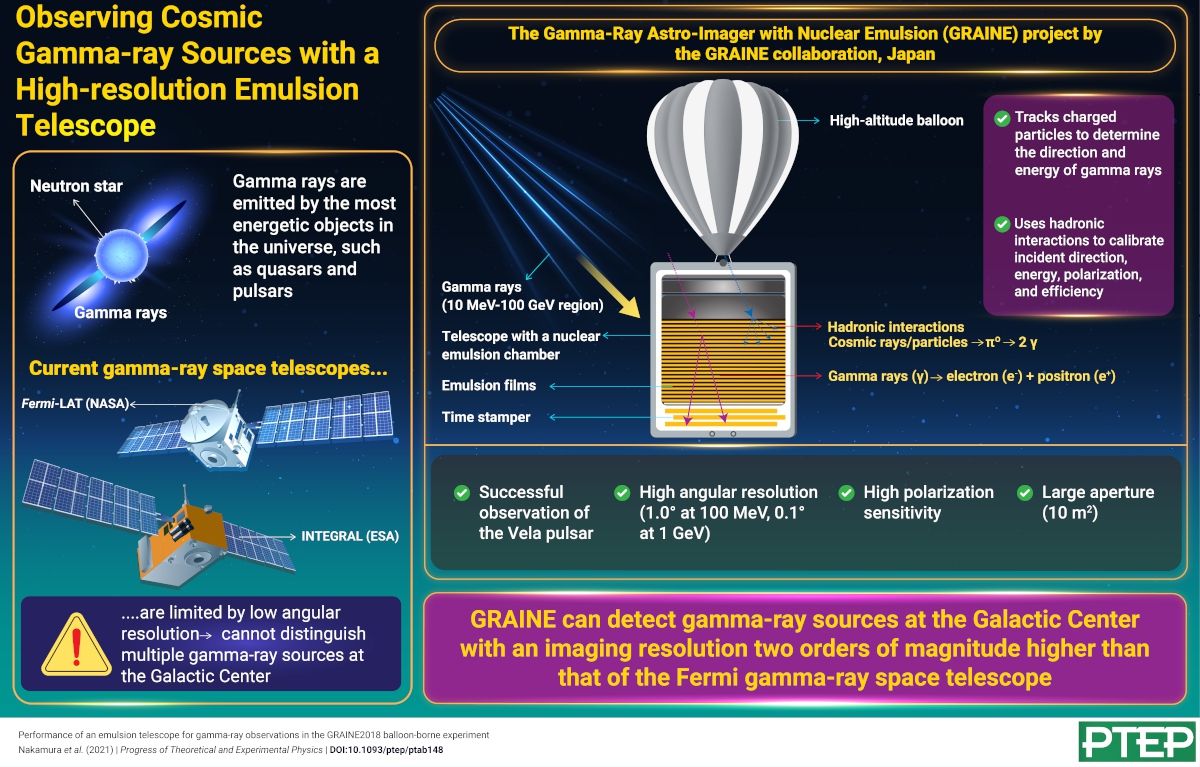High-Precision Observation of Cosmic Gamma-ray Sources with the GRAINE Telescope
© The Physical Society of Japan
This article is on
Performance of an emulsion telescope for gamma-ray observations in the GRAINE2018 balloon-borne experiment
(PTEP Editors' Choice)
Prog. Theor. Exp. Phys. 2021, 123H02 (2021).
A gamma-ray telescope developed jointly by universities in Japan promises an unprecedented imaging resolution that could help distinguish gamma-ray sources observed in our galaxy.

Gamma rays represent the most “energetic” electromagnetic waves in the electromagnetic spectrum, and are generated by some of the most violent events in the universe, such as supernova explosions. Additionally, gamma rays are emitted by energetic objects such as pulsars (spinning neutron stars) and quasars (luminous objects powered by supermassive black holes). Observing gamma rays can, therefore, provide key insights into the evolution of our universe.
Since gamma rays are absorbed by the atmosphere, they can only be observed by telescopes aboard space satellites or high-altitude balloons. The large area telescope on the Fermi Gamma-ray Space Telescope (Fermi-LAT) launched in 2008 was the latest telescope to detect gamma rays in the sub-GeV/GeV energy range. However, the angular resolution of the Fermi-LAT is not high enough to clearly distinguish the multiple gamma-ray sources observed at the Galactic Center (the rotational center of the Milky Way galaxy).
The Gamma-Ray Astro-Imager with Nuclear Emulsion (GRAINE) is a high-resolution gamma-ray telescope that aims to surmount this issue and make precise observations of gamma-ray sources. This balloon-borne telescope developed by Kobe University, Nagoya University, Okayama University of science, Aichi University of Education and Gifu University in Japan uses nuclear emulsion films (a type of photographic plate) and a large aperture area (10 m2) to detect gamma rays in the energy range of 10 MeV-100 GeV.
When charged particles encounter a nuclear emulsion film, they leave behind tracks that can be examined under a microscope, allowing for high-resolution observations. In the case of GRAINE, the nuclear emulsion films detect gamma rays by tracking the position of electrons and positrons generated in pair production.
In 2018, researchers involved in the GRAINE project used the telescope to observe the Vela pulsar, the brightest known gamma-ray source, in collaboration with the Japan Aerospace Exploration Agency (JAXA), who launched the balloon. Along with gamma rays, protons and helium nuclei passed through the emulsion film during the observations. The hadronic interaction between these particles produced short-lived π0 particles that decayed into gamma rays.
In a new study, researchers developed a method to identify these interactions, which could be used to not only detect gamma rays but also calibrate their arrival direction, energy, polarization, and efficiency. Additionally, they developed a high-precision measurement system to automatically record the particle tracks captured on the films.
The proposed methods are expected to improve the imaging resolution of the telescope by two orders of magnitude, and could be implemented during the next balloon experiments with GRAINE to be launched by JAXA on 2023.
Performance of an emulsion telescope for gamma-ray observations in the GRAINE2018 balloon-borne experiment
(PTEP Editors' Choice)
Prog. Theor. Exp. Phys. 2021, 123H02 (2021).
Share this topic
Fields
Related Articles
-
Exploring Recent Advances in the Physics of Biofluid Locomotion
Measurement, instrumentation, and techniques
Cross-disciplinary physics and related areas of science and technology
Electromagnetism, optics, acoustics, heat transfer, and classical and fluid mechanics
Statistical physics and thermodynamics
Mathematical methods, classical and quantum physics, relativity, gravitation, numerical simulation, computational modeling
Structure and mechanical and thermal properties in condensed matter
2023-12-8
This Special Topics Edition of the JPSJ describes the latest advances in the field of biofluid locomotion, shedding light on the underlying physics behind the movement of organisms that swim and fly.
-
Discovering a Local Fluctuation Theorem with Machine Learning
Fundamental Theory of Condensed Matter Physics, Statistical Mechanics, Fluid Dynamics,
Statistical physics and thermodynamics
Measurement, instrumentation, and techniques
2023-10-20
A groundbreaking study reveals a new time-local fluctuation theorem using machine learning, revolutionizing our understanding of deterministic nonequilibrium steady state systems.
-
High Magnetic Field as a Tool for Discovery in Condensed Matter Physics
Magnetic properties in condensed matter
Dielectric, optical, and other properties in condensed matter
Electronic transport in condensed matter
Structure and mechanical and thermal properties in condensed matter
Electron states in condensed matter
Electronic structure and electrical properties of surfaces and nanostructures
Measurement, instrumentation, and techniques
2022-12-13
The Journal of the Physical Society of Japan highlights in this special topic recent advances in modern physics that have been realized with the generation of pulsed high magnetic fields.
-
Will Magnetic Properties near Pressure Induced Quantum Critical Phenomena Be Elucidated?
Measurement, instrumentation, and techniques
Magnetic properties in condensed matter
2021-7-26
Hiraoka et al. developed an opposed anvil-type pressure cell for magnetization measurements which combines a large sample space and is capable of generating higher pressures up to 6.3 GPa.
-
Detecting Weak Quantum Magnetism at High Pressures
Measurement, instrumentation, and techniques
Magnetic properties in condensed matter
2021-6-15
Improved device and method to measure magnetization under high pressure was developed, which brings a quick tool to screen phases of interest in weakly magnetic materials including quantum magnets.
